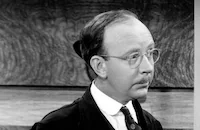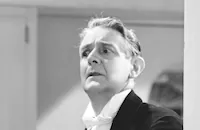Wife Vs. Secretary

Brief Synopsis
Cast & Crew
Clarence Brown
Clark Gable
Jean Harlow
Myrna Loy
May Robson
George Barbier
Film Details
Technical Specs

Synopsis
On their third anniversary, New York magazine publisher Van Stanhope and his wife Linda are still very much in love. Van's mother Mimi, however, feels that his secretary, Helen "Whitey" Wilson, is too attractive not to be a temptation to Van. Linda trusts him and refuses to give in to jealousy, even when some of her friends express the same opinion as Mimi. Van and Whitey's relationship is strictly business, but his dependence on her, and her devotion to him, is a source of displeasure for her fiancé Joe, who wants her to give notice and marry him. She refuses and becomes even more involved with work, helping Van to develop a secret deal to buy a "five cent" weekly from tycoon J. D. Underwood. Because Van is afraid that Hanson House, a rival publishing concern, will ruin his deal, he and Whitey have to be very secretive, even from Linda. At an ice skating party for Stanhope Publications, Linda's jealousy is aroused by a catty remark by one of the executive wives, and she asks Van to transfer Whitey. They quarrel over her jealousy, but make up that night. A short time later, when Van has to go to an advertising convention in Havana, he won't let Linda accompany him because he needs to corner Underwood to close the deal. He later has to summon Whitey to join him, and they work round the clock to finish the needed paperwork for the offer to Underwood. When the deal is closed, they celebrate and for a moment are strongly attracted to each other, but nothing happens. Linda calls a few moments later, however, and when Whitey answers the telephone, she assumes the worst. When Van returns to New York, Linda refuses to listen to him and begins divorce proceedings. Van tries to get her back, but gives up and invites Whitey to sail with him for Bermuda. She has fallen in love with him, but realizing that his happiness is with his wife, she goes to Linda, who is about to sail for Europe, and tells her what a fool she would be to give her husband up. Linda then goes back to Van, and as Whitey leaves the office, she is met by Joe.

Director

Clarence Brown
Cast

Clark Gable

Jean Harlow

Myrna Loy

May Robson

George Barbier

James Stewart

Hobart Cavanaugh
Tom Dugan
George Emery

Marjorie Gateson

Gloria Holden
Margaret Irving
Billy Newell

John M. Qualen

Leonard Carey
Charles Trowbridge
Hilda Howe
Mary Macgregor
Jack Mulhall
Frank Elliott
Greta Meyer
Aileen Pringle

Frank Puglia
Myra Marsh

Holmes Herbert
Frederick Burton
Harold Minjir
Maurice Cass
Tom Herbert
Guy D'ennery
Niles Welch
Richard Hemingway
Paul Ellis
Don Rowan

Clay Clement
Tom Mahoney
Nena Quartaro

Charles Irwin
Andre Cheron
Eugene Borden
Hooper Atchley
Lucille Ward
Clifford Jones
Edward Le Saint
Helen Shipman
Crew
Clarence Brown
Charles Dorian
Cedric Gibbons
William A. Horning
Frank E. Hull
Ray June
Norman Krasna
John Lee Mahin
Jimmy Mchugh
Alice Duer Miller
Douglas Shearer
Herbert Stothart
Hunt Stromberg
Dolly Tree
Edward Ward
Edwin B. Willis

Photo Collections
Videos
Movie Clip


Trailer
Hosted Intro
Film Details
Technical Specs

Articles
Wife Vs. Secretary - Wife vs. Secretary
In her autobiography, Being and Becoming, Myrna Loy recalls working with Jean Harlow and the rest of the cast on Wife vs. Secretary: "Jean was beautiful, but far from the raucous sexpot of her films. As a matter of fact, she began to shake that image in Wife vs. Secretary....She'd begged for a role that didn't require spouting slang and modeling lingerie. She even convinced them to darken her hair a shade, in hopes of toning down that brash image. It worked. She's really wonderful in the picture and her popularity wasn't diminished one bit. Actually we did kind of a reversal in that picture. Jean, supposedly the other woman, stayed very proper, while I had one foot in bed throughout. That's the sexiest wife I've ever played. In one scene, Clark stands outside my bedroom door and we banter, nothing more, but there's just no question about what they've done the night before. Clarence Brown, our director, made it all so subtle, yet, oh, so wonderfully suggestive. (In fact, the only vulgarity in the picture is in the breakfast scene, where I discover a diamond bracelet that Clark has hidden in the brook trout I'm about to eat. It didn't seem chic or funny to me - merely messy, typical of Hollywood's misguided notion of upper-class sophistication. I tried to get them to take it out, but they wouldn't. Needless to say, it's the scene everyone remembers, so what do I know?). Where sex is concerned, the double entendre, the ambiguity, it seems to me, is much more effective than being too explicit. This is something the moviemakers don't seem to understand today."
And speaking of sex, here's what co-star James Stewart had to say about his love scenes with the "blonde bombshell" in the biography, Everybody's Man by Jhan Robbins: "Clarence Brown, the director, wasn't too pleased by the way I did the smooching. He made us repeat the scene about half a dozen times...I botched it up on purpose. That Jean Harlow sure was a good kisser. I realized that until then I had never been really kissed."
Director: Clarence Brown
Producer: Hunt Stromberg
Screenplay: Norman Krasna, Alice Duer Miller, John Lee Mahin (based on a story by Faith Baldwin)
Cinematography: Ray June
Editor: Frank E. Hull
Art Direction: Cedric Gibbons, William A. Horning, Edwin B. Willis
Music: Herbert Stothart, Edward Ward
Cast: Clark Gable (Van Stanhope), Jean Harlow (Helen 'Whitey' Wilson), Myrna Loy (Linda Stanhope), May Robson (Mimi), Hobart Cavanaugh (Joe), James Stewart (Dave).
BW-88m. Closed captioning.
by Kerryn Sherrod

Wife Vs. Secretary - Wife vs. Secretary
Quotes
You're a fool, for which I am grateful.- Helen 'Whitey' Wilson
Trivia
The name of one of the screenwriters, Alice Duer Miller, is seen as the author of an article in a magazine, and Clark Gable remarks, "Hey, Alice has written a very nice article here."
Notes
Most written contemporary and modern sources list the surname of Clark Gable's character as "Sanford." On screen credits give only the first name of "Van," although he is called "Mr. Stanhope" many times throughout the film. In the breakfast table scene between "Van" and "Linda," early in the film, she calls him "Jake" rather than "Van." There is no further mention of the name "Jake," and no explanation for its use in that one scene. At one point in the plot, a new issue of a magazine is brought to Van's attention and the camera focuses on an article written by Alice Duer Miller (co-screenwriter of Wife vs. Secretary) entitled "Are We Debutantes or Are We Mice?" At that point Van says to his subordinate "Hey, Alice has written a very nice article here." According to a news item in Hollywood Reporter William Powell was announced as the male lead in the picture, opposite Jean Harlow and Myrna Loy several months before Miller's story appeared in Hearst's International-Cosmopolitan. Other news items note that Powell was too busy with other projects to appear in the picture when it finally went into production. This was the first film made by Loy after her return to work at M-G-M following a highly publicized salary dispute with M-G-M.

















